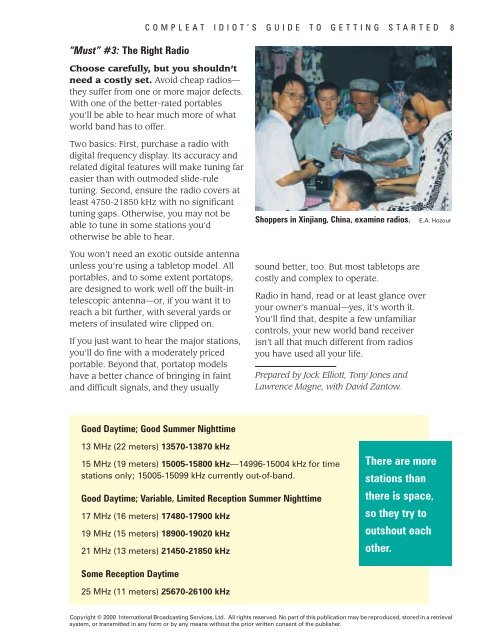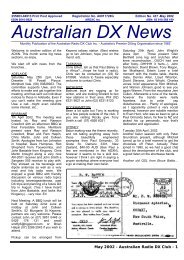Compleat Idiot's Guide to Getting Started
Compleat Idiot's Guide to Getting Started
Compleat Idiot's Guide to Getting Started
Create successful ePaper yourself
Turn your PDF publications into a flip-book with our unique Google optimized e-Paper software.
“Must” #3: The Right Radio<br />
Choose carefully, but you shouldn’t<br />
need a costly set. Avoid cheap radios—<br />
they suffer from one or more major defects.<br />
With one of the better-rated portables<br />
you’ll be able <strong>to</strong> hear much more of what<br />
world band has <strong>to</strong> offer.<br />
Two basics: First, purchase a radio with<br />
digital frequency display. Its accuracy and<br />
related digital features will make tuning far<br />
easier than with outmoded slide-rule<br />
tuning. Second, ensure the radio covers at<br />
least 4750-21850 kHz with no significant<br />
tuning gaps. Otherwise, you may not be<br />
able <strong>to</strong> tune in some stations you’d<br />
otherwise be able <strong>to</strong> hear.<br />
You won’t need an exotic outside antenna<br />
unless you’re using a table<strong>to</strong>p model. All<br />
portables, and <strong>to</strong> some extent porta<strong>to</strong>ps,<br />
are designed <strong>to</strong> work well off the built-in<br />
telescopic antenna—or, if you want it <strong>to</strong><br />
reach a bit further, with several yards or<br />
meters of insulated wire clipped on.<br />
If you just want <strong>to</strong> hear the major stations,<br />
you’ll do fine with a moderately priced<br />
portable. Beyond that, porta<strong>to</strong>p models<br />
have a better chance of bringing in faint<br />
and difficult signals, and they usually<br />
Good Daytime; Good Summer Nighttime<br />
13 MHz (22 meters) 13570-13870 kHz<br />
15 MHz (19 meters) 15005-15800 kHz—14996-15004 kHz for time<br />
stations only; 15005-15099 kHz currently out-of-band.<br />
Good Daytime; Variable, Limited Reception Summer Nighttime<br />
17 MHz (16 meters) 17480-17900 kHz<br />
19 MHz (15 meters) 18900-19020 kHz<br />
21 MHz (13 meters) 21450-21850 kHz<br />
Some Reception Daytime<br />
COMPLEAT IDIOT’S GUIDE TO GETTING STARTED 8<br />
25 MHz (11 meters) 25670-26100 kHz<br />
Shoppers in Xinjiang, China, examine radios. E.A. Hozour<br />
sound better, <strong>to</strong>o. But most table<strong>to</strong>ps are<br />
costly and complex <strong>to</strong> operate.<br />
Radio in hand, read or at least glance over<br />
your owner’s manual—yes, it’s worth it.<br />
You’ll find that, despite a few unfamiliar<br />
controls, your new world band receiver<br />
isn’t all that much different from radios<br />
you have used all your life.<br />
Prepared by Jock Elliott, Tony Jones and<br />
Lawrence Magne, with David Zan<strong>to</strong>w.<br />
There are more<br />
stations than<br />
there is space,<br />
so they try <strong>to</strong><br />
outshout each<br />
other.<br />
Copyright © 2000 International Broadcasting Services, Ltd. All rights reserved. No part of this publication may be reproduced, s<strong>to</strong>red in a retrieval<br />
system, or transmitted in any form or by any means without the prior written consent of the publisher.




